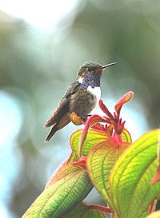
Volcano Hummingbird
Encyclopedia
The Volcano Hummingbird (Selasphorus flammula) is a very small hummingbird
which breeds only in the mountains of Costa Rica
and Chiriqui, Panama
.
This tiny endemic bird
inhabits open brushy areas, paramo, and edges of elfin forest at altitudes from 1850 m to the highest peaks. It is only 7.5 cm long. The male weighs 2.5 g and the female 2.8 g. The black bill is short and straight.
The adult male Volcano Hummingbird has bronze-green upperparts and rufous-edged black outer tail feathers. The throat is grey-purple in the Talamanca range, red in the Poas-Barva mountains and pink-purple in the Irazú-Turrialba area, the rest of the underparts being white. The female is similar, but her throat is white with dusky spots. Young birds resemble the female but have buff fringes to the upperpart plumage.
The female Volcano Hummingbird is entirely responsible for nest building and incubation. She lays two white eggs in her tiny plant-down cup nest 1-5 m high in a scrub or on a root below a south or east facing bank. Incubation takes 15-19 days, and fledging another 20-26.
The food of this species is nectar, taken from a variety of small flowers, including Salvia
and Fuchsia
, and species normally pollinated by insect
s. Like other hummingbirds it also takes some small insects as an essential source of protein. In the breeding season male Volcano Hummingbirds perch conspicuously in open areas with flowers and defend their feeding territories aggressively with diving displays. The call of this rather quiet species is a whistled teeeeuu.
This species is replaced at somewhat lower elevations by its relative, the Scintillant Hummingbird
, Selasphorus scintilla.
Hummingbird
Hummingbirds are birds that comprise the family Trochilidae. They are among the smallest of birds, most species measuring in the 7.5–13 cm range. Indeed, the smallest extant bird species is a hummingbird, the 5-cm Bee Hummingbird. They can hover in mid-air by rapidly flapping their wings...
which breeds only in the mountains of Costa Rica
Costa Rica
Costa Rica , officially the Republic of Costa Rica is a multilingual, multiethnic and multicultural country in Central America, bordered by Nicaragua to the north, Panama to the southeast, the Pacific Ocean to the west and the Caribbean Sea to the east....
and Chiriqui, Panama
Panama
Panama , officially the Republic of Panama , is the southernmost country of Central America. Situated on the isthmus connecting North and South America, it is bordered by Costa Rica to the northwest, Colombia to the southeast, the Caribbean Sea to the north and the Pacific Ocean to the south. The...
.
This tiny endemic bird
Bird
Birds are feathered, winged, bipedal, endothermic , egg-laying, vertebrate animals. Around 10,000 living species and 188 families makes them the most speciose class of tetrapod vertebrates. They inhabit ecosystems across the globe, from the Arctic to the Antarctic. Extant birds range in size from...
inhabits open brushy areas, paramo, and edges of elfin forest at altitudes from 1850 m to the highest peaks. It is only 7.5 cm long. The male weighs 2.5 g and the female 2.8 g. The black bill is short and straight.
The adult male Volcano Hummingbird has bronze-green upperparts and rufous-edged black outer tail feathers. The throat is grey-purple in the Talamanca range, red in the Poas-Barva mountains and pink-purple in the Irazú-Turrialba area, the rest of the underparts being white. The female is similar, but her throat is white with dusky spots. Young birds resemble the female but have buff fringes to the upperpart plumage.
The female Volcano Hummingbird is entirely responsible for nest building and incubation. She lays two white eggs in her tiny plant-down cup nest 1-5 m high in a scrub or on a root below a south or east facing bank. Incubation takes 15-19 days, and fledging another 20-26.
The food of this species is nectar, taken from a variety of small flowers, including Salvia
Salvia
Salvia is the largest genus of plants in the mint family, Lamiaceae, with approximately 700-900 species of shrubs, herbaceous perennials, and annuals. It is one of several genera commonly referred to as sage. When used without modifiers, sage generally refers to Salvia officinalis ; however, it is...
and Fuchsia
Fuchsia
Fuchsia is a genus of flowering plants that consists mostly of shrubs or small trees. The first, Fuchsia triphylla, was discovered on the Caribbean island of Hispaniola in 1703 by the French Minim monk and botanist, Charles Plumier...
, and species normally pollinated by insect
Insect
Insects are a class of living creatures within the arthropods that have a chitinous exoskeleton, a three-part body , three pairs of jointed legs, compound eyes, and two antennae...
s. Like other hummingbirds it also takes some small insects as an essential source of protein. In the breeding season male Volcano Hummingbirds perch conspicuously in open areas with flowers and defend their feeding territories aggressively with diving displays. The call of this rather quiet species is a whistled teeeeuu.
This species is replaced at somewhat lower elevations by its relative, the Scintillant Hummingbird
Scintillant Hummingbird
The Scintillant Hummingbird is the smallest hummingbird within its range, which includes only the mountains of Costa Rica and western Panama....
, Selasphorus scintilla.
External links
- Volcano Hummingbird photo; Article
- Volcano Hummingbird videos on the Internet Bird Collection

